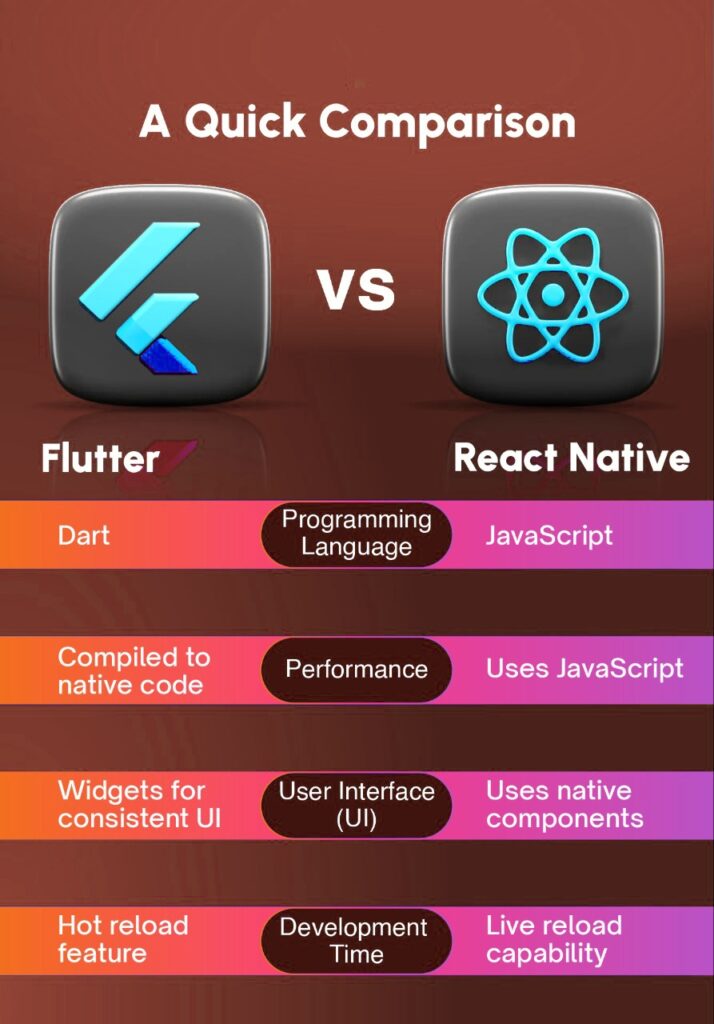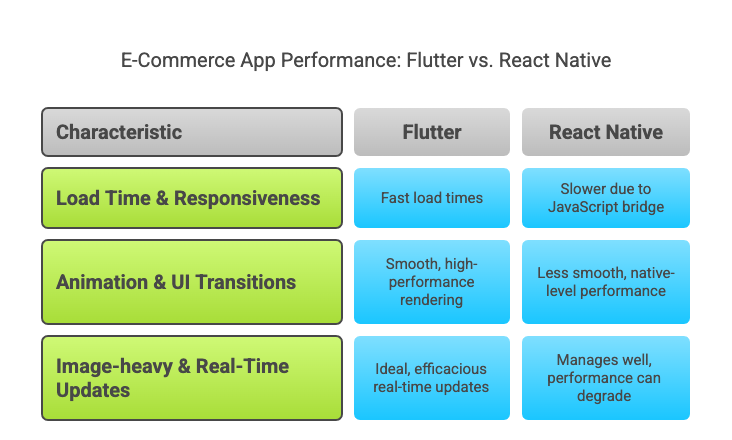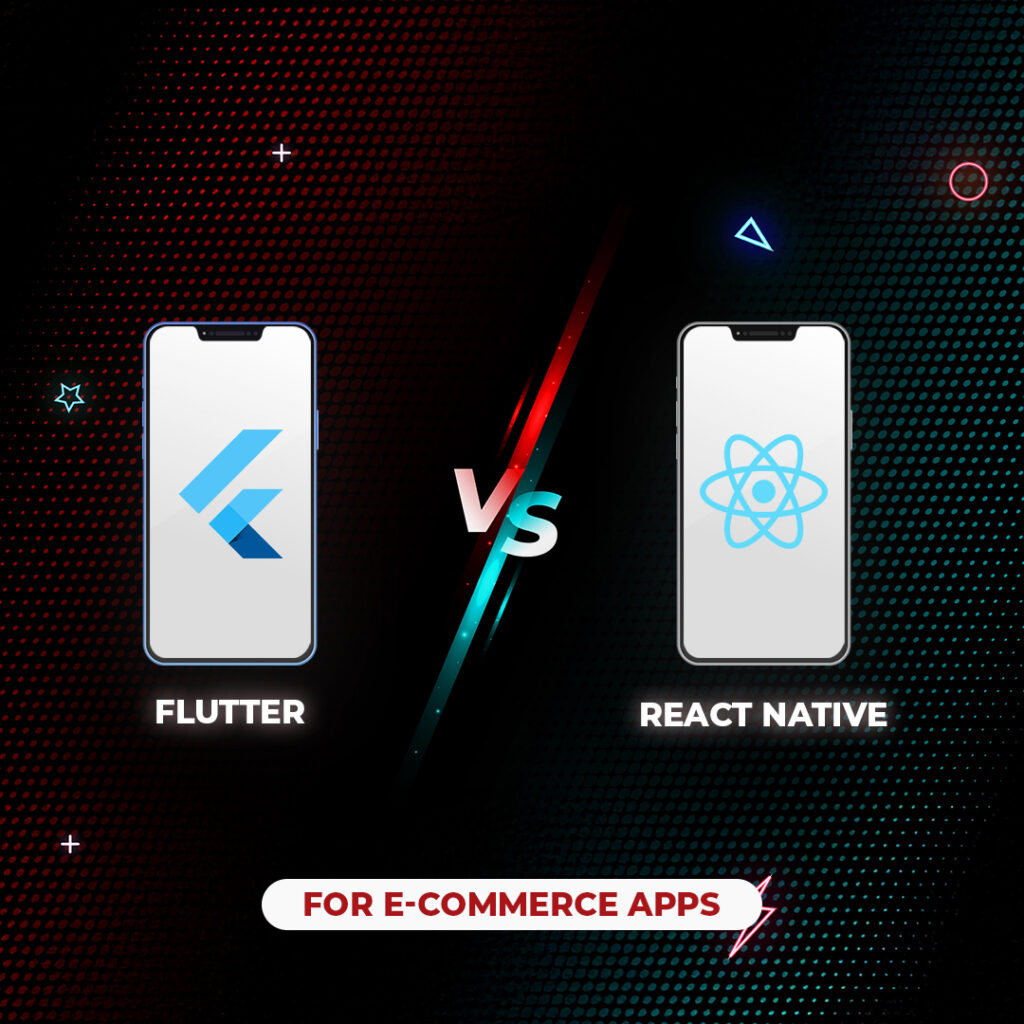|
Getting your Trinity Audio player ready...
|
Cross-platform development has revolutionized mobile app creation since it allows businesses to develop applications using a single code base for both iOS and Android platforms. Such an approach reduces time-to-market and development costs significantly for e-commerce apps typically known for high-end user experience (UX) and instant speed of their solutions, all while being prepared to endure enormous high traffic and easily integrate with the backend services such as payment gateways, product catalogues, etc.
Flutter and React Native are the two popular cross-platform frameworks leading the list of the best cross-platform options. Both frameworks have pros and cons, and the choice depends on performance, scalability, and budget.In this blog, we will compare the two cross-platform frameworks Flutter and React Native in terms of e-commerce app development and help you make the right decision on which of these two methods will suit your business the most and why Esferasoft would be your perfect partner for taking advantage of these technologies in high-quality e-commerce solutions.
Quick Overview: Flutter vs. React Native

What is Flutter?
Flutter is an open-source UI framework developed and maintained by Google used to build natively compiled applications for all devices, including mobile, web, and desktop, from a single codebase. Flutter is very popular among its users due to its performance rendering engines, which enable developers to build highly rich, fast apps using customized UIs. One of the major attractive features of Flutter is its hot reload facility, and Google services integration makes it a comfortable choice for developers.
What is React Native?
Meta (formerly Facebook) creates React Native as a JavaScript framework used in building applications for mobile devices. The advantage of this cross-platform programming is that both Android and iOS apps share the same codebase using an access method called Native Components. React Native is based on React, a popular library of JavaScript that builds user interfaces, features a large community of developers, and is fantastic for creating UIs.
Flutter vs React Native: Backed by Google and Meta/Facebook.
Tech giants support both Flutter and React Native: Google supports Flutter, while Meta (formerly Facebook) supports React Native. All three of them provide strong support, regular updates, and a large ecosystem of tools and libraries for developers.
Basic Technical Comparison Table
| Feature | Flutter | React Native |
| Language | Dart | JavaScript |
| Performance | High-performance, compiled code | Uses native components, slightly slower |
| UI Customization | Highly customizable, custom widgets | Uses native components, limited customization |
| Development Speed | Fast with hot reload | Fast with hot reload |
| Ecosystem and Libraries | Growing but still smaller than React Native’s | Extensive and mature |
| Learning Curve | Steep (Dart language) | Moderate (JavaScript and React knowledge) |
Performance in E-Commerce Context

Load Time and Responsiveness Feature
- Performance really matters in the competitive e-commerce industry. If e-commerce sites have a slow loading time during browsing or purchasing, most customers will leave.
- The Dart language shines in this respect since it compiles native ARM code directly, leading to really fast load times and performance inertia. Flutter apps are themselves a very responsive kind because they resorted to native compilation.
- For instance, React Native supports a JavaScript bridge to connect to the native modules. React Native is slower than Flutter, even though its performance is already above average. The issue is mainly observed in apps that make heavy use of complex animations and real-time updates, which behave slightly slower than their counterparts.
Animation and UI Transitions
- Items in e-commerce apps usually have rich animations and smooth transitions, like adding an item to the shopping cart, scrolling photos of the product, and showing its details.
- Developers can achieve rich animations with smooth transitions through a high-performance rendering engine provided by Flutter. Flutter’s custom animation flexibility makes it an ideal choice for complex visual elements in an app.
- React Native also has an animation module, but in terms of performance, the animations aren’t up to par with Flutter’s native-level performance. It can create animations, but they may not be as smooth, particularly in apps focused on images or heavy animation.
Image-heavy and Real-Time Updates
- Flutter is the ideal framework for applications, particularly those that need to load and display large images or product catalogues. It can also do quite efficacious real-time updates when the stocks change or prices are updated to ensure the user experience is very sound and fast.
React Native manages real-time updates well, although performance can degrade among apps with complex data structures due to the overhead of the JavaScript bridge.
UI/UX Capabilities for E-Commerce
Custom Design Flexibility
A unique and visually appealing design can significantly impact the attraction and retention of customers for e-commerce apps.
- Flutter allows complete design freedom with its custom widgets and the ability to control every pixel on the screen. It’s a perfect match for e-commerce apps that want to offer a distinct look and feel.
- React Native relies on native components, which can limit flexibility. While it provides excellent UI options, custom designs can sometimes be challenging to implement.
Component Libraries (Material Design vs. Native Components)
- Flutter uses Material Design by default, offering a rich set of pre-built components that can be easily customized. This feature is particularly beneficial for e-commerce apps aiming for a consistent and modern look across platforms.
- React Native uses native components, meaning it adheres to the design guidelines of iOS and Android separately. This type of architecture ensures a more native look and feel but might require more effort to maintain consistency across platforms.
Consistency Across Platforms
Maintaining a consistent experience across multiple platforms is essential for e-commerce apps.
- Flutter ensures consistency as it uses the same codebase for both iOS and Android, with the same UI components and features.
React Native is more likely to show minor differences across platforms, especially if the native components are highly personalized.
Development Speed & Time to Market
Hot Reloading Features
- Flutter and React Native both execute the capability of hot reloading, allowing developers to see changes instantaneously during development. The actual time saved, in terms of debugging and QA, therefore, is converted into development time.
Developer Availability
- React Native does have developers available in large numbers; it uses JavaScript, which is one of the most popular programming languages. Finding React Native developers is fairly easy.
- In contrast, developers working with Flutter are shorter in number because Dart is not as well known as JavaScript. But the framework is being accepted in the industry, and the community is growing.
Learning Curve and Community Support
- On the one hand, having to learn Dart may slow the initial development of Flutter. The learning curve, however, is facilitated by first-rate documentation and a growing community.
- React Native, on the other hand, is simply JavaScript and React, making the entrance barrier for developers with knowledge in those languages lower. React Native is blessed with a large community and numerous empowering libraries.
Integration with Backend & Third-Party Services
E-commerce apps rely heavily on third-party services, such as payment gateways, CRM systems, and analytics tools. Both Flutter and React Native support integrations with popular third-party services.
- Flutter offers excellent support for API integration, payment gateways, and other third-party services. It’s easy to integrate with popular services like Stripe, PayPal, and Firebase.
React Native has a more mature ecosystem for backend integrations. With a wide variety of plugins and libraries, React Native can seamlessly integrate with any backend service or API.
Maintenance and Scalability for Long-Term Growth
Code Maintenance and Updates
- Flutter allows for easier code maintenance as it uses a single codebase for both platforms. The Dart language is also well-suited for large, scalable applications, making future updates and maintenance simpler.
- React Native uses a bridge to connect JavaScript to native components, which can sometimes complicate maintenance, especially with large-scale apps.
Compatibility with Growing Product Catalogs
- Flutter handles large catalogues well with its highly optimized performance and ability to load images efficiently.
- React Native can handle growing catalogues, but it may require optimizations to improve performance as product data increases.
Multi-Language, Multi-Currency Support
Both frameworks support multi-language and multi-currency features, which are critical for global e-commerce businesses.
- Both Flutter and React Native offer strong localization support, enabling developers to build apps that are easily adapted to various languages and currencies.
Cost Comparison
Development Cost
- Flutter and React Native are both cost-effective compared to native development, but the overall cost will depend on the complexity of the app. Since React Native has a larger developer pool, it may be slightly cheaper to find qualified developers for it.
- Flutter might require more investment in finding skilled developers, but its fast development cycle can save costs in the long run.
Maintenance Cost
- Maintenance costs will be similar for both frameworks, but Flutter’s single codebase might lead to slightly lower long-term maintenance costs.
Developer Hiring or Outsourcing Expenses
- React Native has a larger pool of developers, which can make hiring or outsourcing easier and more affordable.
- Flutter is newer, so finding experienced developers may be pricier, but the demand is steadily rising.
Real-World Use Cases
Brands or Startups Using Flutter for E-Commerce
- Alibaba: One of the largest e-commerce platforms, using Flutter to provide a smooth experience for its mobile users.
- Google Ads: While not strictly an e-commerce app, Google Ads uses Flutter for its cross-platform mobile apps, showing Flutter’s scalability for large, high-traffic apps.
Brands Using React Native for E-Commerce
- Walmart: Walmart uses React Native for its mobile app to handle a giant inventory and provide real-time updates, demonstrating React Native’s ability to scale.
- Airbnb: Airbnb’s mobile app was initially built with React Native, showing its suitability for complex apps that need scaling.
When to Choose Flutter vs. React Native for Your E-Commerce App

Based on Project Size
Flutter is better suited for larger, more complex apps with custom designs and animations.
React Native is a viable option for apps with simpler designs and those that need to be developed quickly.
Based on Timeline
- Flutter offers faster time-to-market for projects with complex UI elements.
- React Native is ideal for apps that need rapid development and a large pool of developers.
Based on Budget
- Flutter might require more initial investment but could save money in the long run due to its single codebase and high performance.
- React Native is often cheaper to start with due to its larger developer base.
Based on Design or Performance Requirements
- Flutter excels at custom design flexibility and performance, making it ideal for high-end e-commerce apps.
- React Native is excellent for apps that don’t require complex UI elements but need to be fast and reliable.
Why Esferasoft Is the Ideal Partner for E-Commerce App Development
At Esferasoft, we specialize in building high-performance, scalable e-commerce apps using both Flutter and React Native. Our expertise spans custom and white-label e-commerce solutions, ensuring that we can deliver a solution that meets your specific business needs. Whether you’re looking for a custom-designed app or a white-label solution, we leverage both frameworks to deliver optimized, fast, and reliable apps.
We understand the unique challenges e-commerce businesses face, from handling large product catalogues to integrating with third-party services like payment gateways. Let us help you build an app that scales with your business and provides a seamless shopping experience for your customers.
Conclusion:
Both Flutter and React Native offer unique strengths for building e-commerce apps, and the right choice depends on your business’s specific needs. While Flutter provides a personalized, performance-optimized solution, React Native offers quick development and a larger developer pool.

